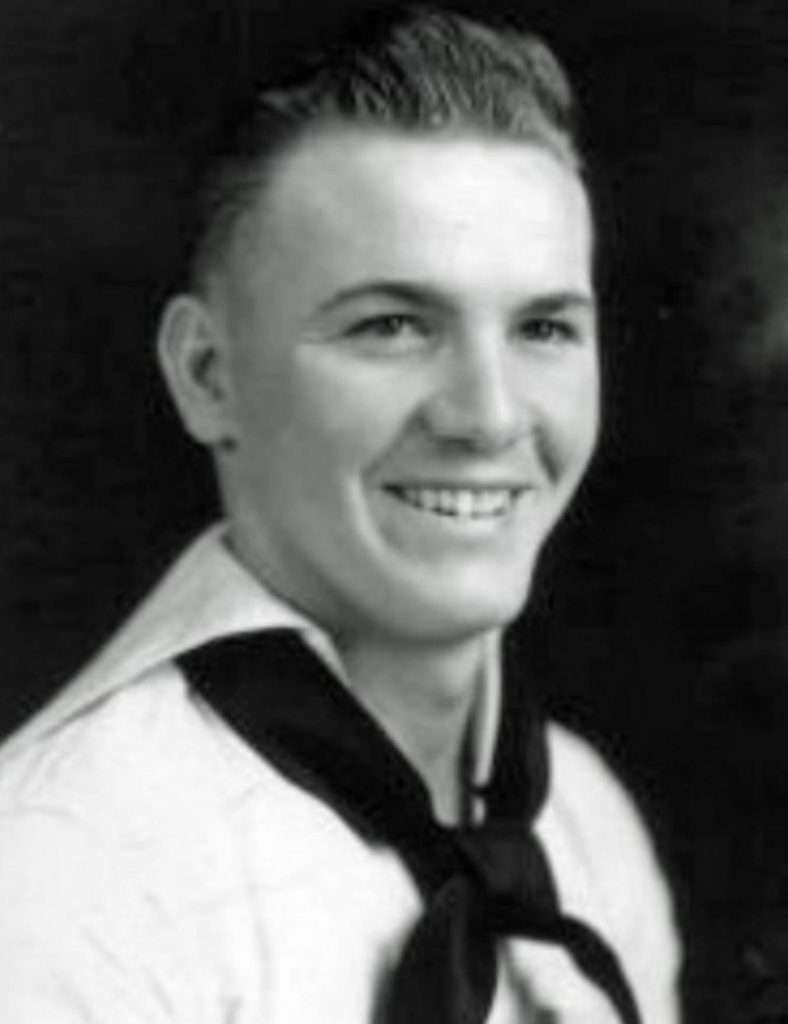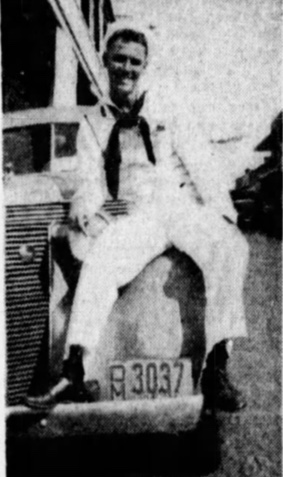
- Rank: Seaman 1st Class
- Serial No: 321-21-91
- Branch: US Navy
- Home Town: Fredericksburg, IA
- Date Of Birth: July 15, 1920
- Disposition: Unrecovered
- Family DNA on File: YES
S1c William Vinton Ball
The death of William Vinton Ball in the Japanese attack on Pearl Harbor led to even greater tragedy.
His story is easiest to follow by starting at the beginning. Bill, as he was known, was born July 15, 1920, in Clay County, Iowa, to Rebecca Sutherland Ball, a homemaker, and Wiley Ball, a farm laborer.
The family moved in 1936 to a farm just east of Fredericksburg, a town of about 650 in northeast Iowa.
A brief mention in The Fredericksburg News in March 1936 welcomed Bill and his brother Masten — who was older by a year — to the local high school. They played baseball, Masten as catcher and Bill as pitcher, on the school team. Masten graduated that May.

He enlisted in the Navy on Dec. 21, 1937, following the tradition of his father, who enlisted in 1907 and then again in 1918 during World War I.
Bill, meanwhile, became a good enough ball player that he had hopes of signing with a pro team. But first he graduated in the spring of 1938 and in October also enlisted in the Navy. By then Masten was serving on the U.S.S. Arizona.
The brothers wanted to be together and, as was common then, the Navy honored their request. Bill went aboard the Arizona on Jan. 1, 1939.
He was a seaman first class when he was killed on Dec. 7, 1941. Masten, a fireman first class, was blown off the deck of the ship but survived. He later said that Bill was below deck when the ship was bombed and exploded.
Bill played third base on the Arizona’s baseball team, which competed against teams from other ships. The Arizona’s newsletter reported in April 1940 that he was batting .300 for the season.
It was just before Christmas 1941 that Wiley Ball learned of his son’s death. He tried to enlist for the third time, but was turned down because he was in his late 50s.
But others who wanted to avenge Bill’s death did enlist.
Before the family had moved to Fredericksburg Bill had become friends with the five Sulllivan brothers in nearby Waterloo. All five were working at a packing company in Waterloo before they traveled to Des Moines on Jan. 3, 1942, to enlist. The two oldest, George and Frank, had already served in the Navy and had been aboard a destroyer at Pearl Harbor. “And that’s just where we want to go now,” Frank told a reporter.
The brothers wanted to stay together. It isn’t clear whether the Navy first denied their request or just advised against it. Either way, the brothers got their wish and went aboard a light cruiser, the U.S.S. Juneau, on the day it was commissioned, Feb. 14, 1942. The other three brothers were Joseph, Madison and Albert. The latter was married and had a toddler son.
The Juneau was in the thick of the Pacific battle by October 1942 and in early November joined the fight for Guadalcanal. The ship was torpedoed and quickly sank on Nov. 13, killing 687 men. Sister ships left the area, not realizing that about 100 Juneau sailors, apparently including at least one Sullivan brother, had survived. By the time rescuers returned a week later, about 10 men were alive. All five Sullivans were dead.
Years later, Albert’s widow, Katherine, recalled, “Being young you don’t know what it means to be in war. You think, ‘Oh, they’re going to be back.’ And all of a sudden, they’re not back.”
In a letter to the Navy dated only January 1943, Alletta Sulllivan, pleaded for news about her sons. Another local mother had received a letter from her son saying the Sullivans were dead. The rumor is “all over town now, and I am so worried,” Mrs. Sullivan wrote. Her last letter from them was dated Nov. 8. She said that she “hated to bother you,” but that she wanted to know the truth. No matter what, she wrote, she would travel to Portland, Oregon, in February to christen a tug, the Tawasa, because her sons wanted her to do it.
The official notification that the brothers were missing in action was delivered to the family on Jan. 12. Mrs. Sullivan, a homemaker, and her husband, Thomas, a railroad conductor, went not only to Oregon but around the country to support the war effort. They visited factories to encourage employees to speed up production and spoke at rallies for war-bond sales.
Their daughter, Genevieve, enlisted in the Naval Women’s Reserve (known as the WAVES) and served 21 months before she was discharged in 1944.
It is often said that the death of so many from one family prompted the Navy to change policy and refuse to permit brothers to serve together. That is not entirely correct. After the deaths of the Sullivans, the Navy endeavored to keep brothers apart. But in the middle of a war, military needs came first. If brothers had specialized skills that were in short supply, they sometimes served on the same ship. And, of course, transferring brothers who were already together wasn’t possible out on the sea.
Meanwhile, Masten Ball made the Navy his career, serving 20 years. He died in 1985 in Connecticut.
A destroyer named “The Sullivan” was commissioned in 1943, followed by another in 1993. The brothers were the subject of a popular 1944 movie, “The Sullivans.” The Sullivan Brothers Iowa Veterans Museum was dedicated in November 2008 in Waterloo. It’s well worth a visit if you are in the area. And in March 2018, the wreckage of the Juneau was located by oceanographer Robert Ballard, best known for finding the wreckage of the Titanic.
Sources: The Fredericksburg (Iowa) News; the Courier of Waterloo, Iowa; the Sioux City (Iowa) Journal; Iowa application for World War II service compensation; Census; Navy muster rolls; Connecticut death index and grave marker; the National Archives; Naval History & Heritage Command. This profile was researched and written on behalf of the U.S.S. Arizona Mall Memorial at the University of Arizona.
